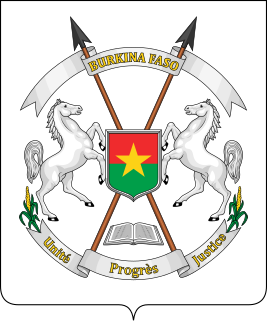
Burkina Faso is a landlocked country in West Africa with an area of 274,200 km2 (105,900 sq mi), bordered by Mali to the northwest, Niger to the northeast, Benin to the southeast, Togo and Ghana to the south, and the Ivory Coast to the southwest. It has a population of 20,321,378. Previously called Republic of Upper Volta (1958–1984), it was renamed Burkina Faso by President Thomas Sankara. Its citizens are known as Burkinabè, and its capital and largest city is Ouagadougou.

The Politics of Burkina Faso takes place in a framework of a semi-presidential republic, whereby the Prime Minister of Burkina Faso is the head of government, and of a multi-party system. The President of Burkina Faso is the head of state. Executive power is exercised by both the President and the Government. Legislative power is vested in both the government and parliament. The party system was dominated by the Congress for Democracy and Progress (CDP) until the 2014 Burkinabé uprising. Since then, the CDP has lost influence. The Judiciary is independent of the executive and the legislature. The Economist Intelligence Unit rated Burkina Faso a "hybrid regime" in 2019.

The Burkina Faso Armed Forces is the term used for the national military of Burkina Faso. The service branches of the armed forces include its Army, Air Force, National Gendarmerie and People's Militia. Being a landlocked country, Burkina Faso has no navy.
Gendarmerie Nationale most commonly refers to:

The mass media in Burkina Faso consists of print media and state-supported radio, news, and television stations, along with several private broadcasters with programs consisting of sports, music, cultural, or religious themes.

The National Gendarmerie is one of two national law enforcement forces of France, along with the National Police. The Gendarmerie is a branch of the French Armed Forces placed under the jurisdiction of the Ministry of the Interior, with additional duties from the Ministry of Armed Forces. Its responsibilities include policing smaller towns, suburbs and rural areas, along with special subdivisions like the GSPR. By contrast, the National Police is a civilian law enforcement agency that is in charge of policing cities and larger towns. Because of its military status, the Gendarmerie also fulfills a range of military and defence missions, including having a cybercrime division. The Gendarmerie has a strength of around 102,269 people.

As in many other countries with a French colonial heritage, law enforcement in Benin was a responsibility primarily shared by a gendarmerie and a police force. Since January 2018, the Republican Police of Benin is the unique law enforcement force.
Like many other countries with a French colonial heritage, law enforcement in Burkina Faso is a responsibility primarily shared by the gendarmerie and the police.

The principle law enforcement agency in Burundi is the National Police of Burundi. The police falls within the jurisdiction of the Ministry of Public Security. It is separate from the National Intelligence Service (SNR), the state intelligence agency.
Law enforcement in Mali is the responsibility of the National Police Force, which is subordinate to the Ministry of Internal Security and Civil Protection. The National Police Force shares responsibility for internal security with the Gendarmerie, a paramilitary organization; the police are responsible exclusively for urban areas, while the Gendarmerie's primary responsibility is for rural areas, though it may also reinforce the police when needed. According to The Wall Street Journal, each organization has approximately 5,000 personnel, while Interpol gives a figure of over 7,000 for the police.

The Gendarmerie Nationale is the national paramilitary police force of Niger. One of two paramilitary police units of the nation, the Gendarmerie Nationale is modeled on the Gendarmerie of former colonial power, France. Its purpose is to provide police protection outside of urban areas, patrolled by the National Police . The Gendarmerie Nationale is a centrally controlled 3,700 member paramilitary police force that provides policing outside those jurisdictions policed by the Police Nationale, usually smaller towns and rural areas. It is uniformed, ranked and trained in military fashion.
Responsibility for law enforcement in Togo is primarily shared by the Police nationale, the civilian national police, and the paramilitary Gendarmerie nationale togolaise.

The National police of Niger are one of two Police forces, previously under the control of the Armed Forces of Niger, but following the Constitution of 1999, come under the control of the Ministry of the Interior. They are responsible for security and law enforcement in urban areas, and the protection of government buildings, institutions, and through special agencies, the security of government leaders.

The Modèle 1951 helmet was a military helmet used by the French military, iconic of the Algerian War. It replaced a variety of helmets used during the Second World War, including the Adrian helmet, Modèle 1945 helmet and American-supplied M1 Helmet.
A gendarmerie is a police force that is generally part of the armed forces of a country, and is responsible for policing the civilian population
Major in France, is a senior superior military rank across various military and security institutions with history dating back well beyond the 18th century.
Events in the year 2012 in Burkina Faso.
Events in the year 2010 in Burkina Faso.














